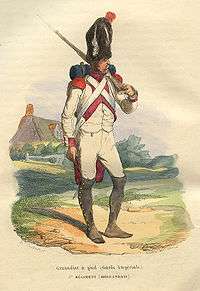Dutch grenadiers
The Dutch grenadiers were a French guard regiment from 1810 until 1813. They were originally formed out of Louis Bonaparte's Royal guard.
| "Les Grenadiers Hollandais" (The Dutch Grenadiers) | |
|---|---|
 | |
| Active | 1810–1813 reraised in April 1815 |
| Country | France |
| Branch | French Army |
| Type | Guard grenadiers |
| Role | Élite troops |
| Engagements | Smolensk Battle of Krasnoj |
Early history
On the 9th on July the Dutch grenadiers, then the 2ème Régiment de grenadiers à pied de la Garde impériale, were added to the imperial guard. Still dressed in the Dutch uniforms they start their march to Paris where they served for over one and a half years as palace guard.
Uniforms
The Dutch Grenadiers were one of the only regiments to use white uniforms. When they were first added to the guard they had worn the old royal guard uniforms. They kept that uniforms but with adjustments. Before they had bowl buttons with the Dutch lion on them that was changed into flat ones with an imperial eagle. Unlike other foreign regiments they did not have a copper plate with a N and an eagle they had no plate. Their Pouch with the standing Dutch lion was changed into one with the imperial eagle. Their bearcaps differed with the one from the 1st and 2nd grenadiers of the guard. They had 45 cm tall bearskins and where thinner while the 3eme had 40 cm tall bearskins and were wider.
Russian campaign
On 16 August, the Army arrived at Smolensk, the town being defended by 120,00 Russian troops. By 1 in the morning of the 17th of July, Smolensk was in French hands. The stench of the quickly decaying corpses prevented the Guard from enjoying the pleasures of victory in the town. On the 19th, a Russian general, found hiding in the town, refused to surrender and was bayoneted by the Grenadiers. On the 24th, the army began to quit Smolensk, for the Russians were withdrawing to defend Moscow. The Regiment survived Borodino intact, like the rest of the Guard Infantry who saw no action even after repeated requests that the Guard would tip the battle in Napoleon’s favour rather than a long drawn out stalemate. After Krasnoj the 3eme only had 40 men left and only 7 had reached the fatherland after the campaign.
References
- http://www.militairmagazijn.nl/bronnen/armamentaria/artikel/bronnen_armas_xml_46a29809-1c0c-43ae-9d9e-364e04677596/
- "Archived copy". Archived from the original on 2016-04-23. Retrieved 2017-05-02.CS1 maint: archived copy as title (link)